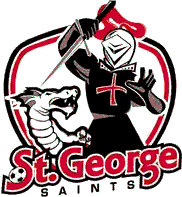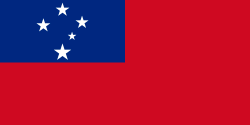St George FC
 | |||
| Full name | St George Football Club | ||
|---|---|---|---|
| Nickname(s) | Saints | ||
| Founded | 1957 | ||
| Ground | St George Stadium | ||
| Capacity | 15,000 | ||
| President | unknown | ||
| Head Coach | Wally Savor | ||
| League | NPLNSW2 | ||
| Website | Club website | ||
|
| |||
St George FC, commonly called St George Saints or just Saints, is a semi-professional Australian association football club based in the St George district in the south of Sydney. The club was founded by Hungarian immigrants in 1957 as Budapest Club and by 1965 was renamed to St. George-Budapest Club.
One of the top clubs of Australia from the 1960s to the 1980s. St George currently competes in the second-highest tier of Australian association football, the NSW National Premier League Men's 1 after achieving promotion in 2013 from the NSW Super League. Their home ground is the St George Stadium.The club returned in 2015 to the PS4 NPLNSW Men's 2 competition.
History
The club was formed shortly after the Hungarian Revolution of 1956 by Hungarian Immigrants and was originally known as Budapest. In the 1960s, led by pioneering football administrator Alex Pongrass, it became one of the first ethnic clubs in NSW to search for a district to call home and it chose the St George district. It later became known as St George-Budapest before shortening its name to St George some years later. They opened a licensed club, named Soccer House, in the suburb of Mortdale in 1968. In 1969 Frank Arok, the first full-time coach in Australia was appointed, serving two stints as coach, the last ending in 1983 when he left to coach the Socceroos. In between Arok's two stints as coach, Rale Rasic was coach, coaching the club at the same time as he was coaching the Socceroos. In 1971 the club was invited to an international club tournament in Tokyo, Japan. It won and remained the highest ever international achievement by an Australian club side, until the Western Sydney Wanderers 2014 victory in the Asian Champions League.
Such was the dominance of St George in those days that up to 10 players on the national team would be St George players. In 1974 the team set a record for the most players from any one club side on a World Cup team when 5 of their players were on the Australian side that started against East Germany in the World Cup that year in West Germany, including the vice-captain of the side, the late Australian footballing legend Johnny Warren. Another notable player (albeit at a lower level), was football commentator Les Murray. Together with Warren they would become known as "Mr and Mrs Soccer"[1] and would become the faces of football in Australia through their commentary work on SBS Television.
In 1975 at the urging of some former Hungarian soccer greats and youth coach Bob Szatmari, the meeting determined to establish the Australian National Soccer League took place at Soccer House with representatives from all founding clubs, including Hakoah Club (later known as Eastern Suburbs and Sydney City) president and Westfield Group founder and chairman Frank Lowy and Leslie Szatmari. The competition started in 1977 and St. George-Budapest won the competition in 1983. They played in the league until the 1990/91 season. Since then they have played in state competitions. In 2005 the side was controversially axed from the new look New South Wales Premier League and took legal action against the decision along with the Bonnyrigg White Eagles, but were unsuccessful.
Recent history
In 2012 the club competed in the New South Wales Super League, the second tier of state football, finishing seventh out of twelve clubs and missing out on the finals.[2] In 2013, St George were promoted from the NPL NSW Men's 2 after taking out the league championship, finishing seven points ahead of the second placed Macarthur Rams FC. The club also won the Grand Final, beating the Rams in the semi-final 2–1 and then beating Mounties Wanderers FC 3–1 in the final. The joy was not to last long, though, as in 2014, the club was immediately relegated back to the second tier of football in NSW. Managing just four wins and four draws in 22 games, St George finished dead last in the top tier. The Saints endured another tough season in 2015, finishing third last in the NPL NSW Men's 2.
Current squad
St George FC IGA NPL Men's 1 1st Grade Squad[3]
Note: Flags indicate national team as defined under FIFA eligibility rules. Players may hold more than one non-FIFA nationality.
|
|
Honours
- Champions: 1983
- Runner Up: 1982, 1989
- National Soccer League Cup
- Runner Up: 1979
- Champions: 1962, 1972, 1976
- Runner Up: 1964, 1965, 1967, 1969, 1970, 1971, 1975, 1981
- Champions: 2013
Season results
| Season | League | Place | Cup |
|---|---|---|---|
| 1961 | NSW 1 | 7th | |
| 1962 | NSW 1 | 1st | |
| 1963 | NSW 1 | 6th | |
| 1964 | NSW 1 | 2nd | |
| 1965 | NSW 1 | 2nd | |
| 1966 | NSW 1 | 3rd | |
| 1967 | NSW 1 | 2nd | |
| 1968 | NSW 1 | 11 | |
| 1969 | NSW 1 | 2nd | |
| 1970 | NSW 1 | 2nd | |
| 1971 | NSW 1 | 2nd | |
| 1972 | NSW 1 | 1st | |
| 1973 | NSW 1 | 3rd | |
| 1974 | NSW 1 | 3rd | |
| 1975 | NSW 1 | 2nd | |
| 1976 | NSW 1 | 1st | |
| 1977 | NSL | 6th | |
| 1978 | NSL | 7th | |
| 1979 | NSL | 11th | 2nd |
| 1980 | NSL | 14th | |
| 1981 | NSW 1 | 2nd | |
| 1982 | NSL | 2nd | |
| 1983 | NSL | 1st | |
| 1984 | NSL | 10th | |
| 1985 | NSL | 5th | |
| 1986 | NSL | 3rd | |
| 1987 | NSL | 3rd | |
| 1988 | NSL | 8th | |
| 1989 | NSL | 2nd | 3rd |
| 1989–90 | NSL | 10th | |
| 1990 | NSW 1 | 4th | |
| 1990–91 | NSL | 10th | |
| 1992 | NSW 2 | 11th | |
| 1993 | NSW 2 | 11th | |
| 1994 | NSW 1 | 10th | |
| 1995 | NSW 2 | 5th | |
| 1996 | NSW 2 | 10th | |
| 1996 | NSW 2 | 3rd | |
| 1997 | NSW 2 | 9th | |
| 1998 | NSW 2 | 12th | |
| 1999 | NSW 3 | ||
| 2000 | NSW 2 | 4th | |
| 2012 | NSW 2 | 7th | |
| 2013 | NSW 2 | 1st | |
| 2014 | NSW 1 | ||
Notable players







References
- ↑ Andy Harper. "Mr and Mrs Soccer / Andy Harper". National Library of Australia. Retrieved 3 February 2010.
- ↑ Men's Super League 2012 final table. Retrieved 30 January 2013
- ↑ Matchday Program NSW NPL Round 12 2014. Retrieved 9 June 2014
- ↑ http://www.ozfootball.net/ark/Players/A/AA.html
- ↑ http://www.ozfootball.net/ark/NSL/1978/Round14.html
External links
| Preceded by Sydney City |
NSL Champions 1983 |
Succeeded by South Melbourne |